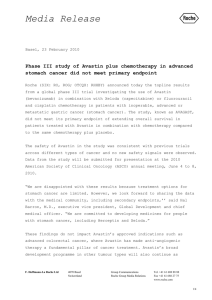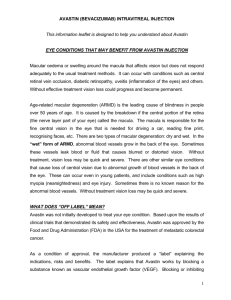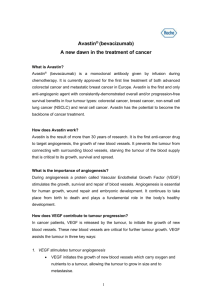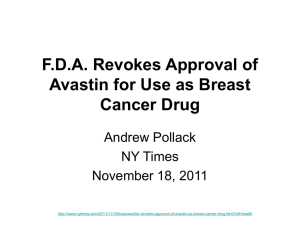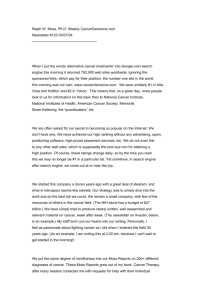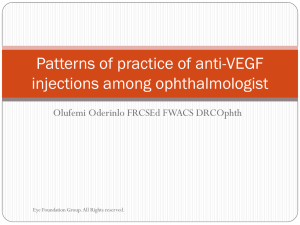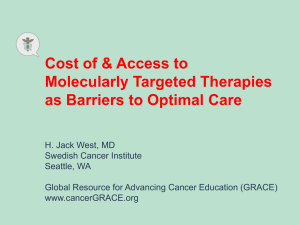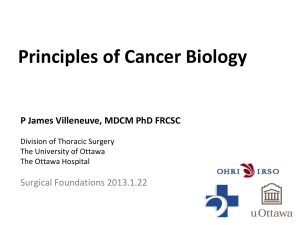Avastin - TheNewsMarket
advertisement
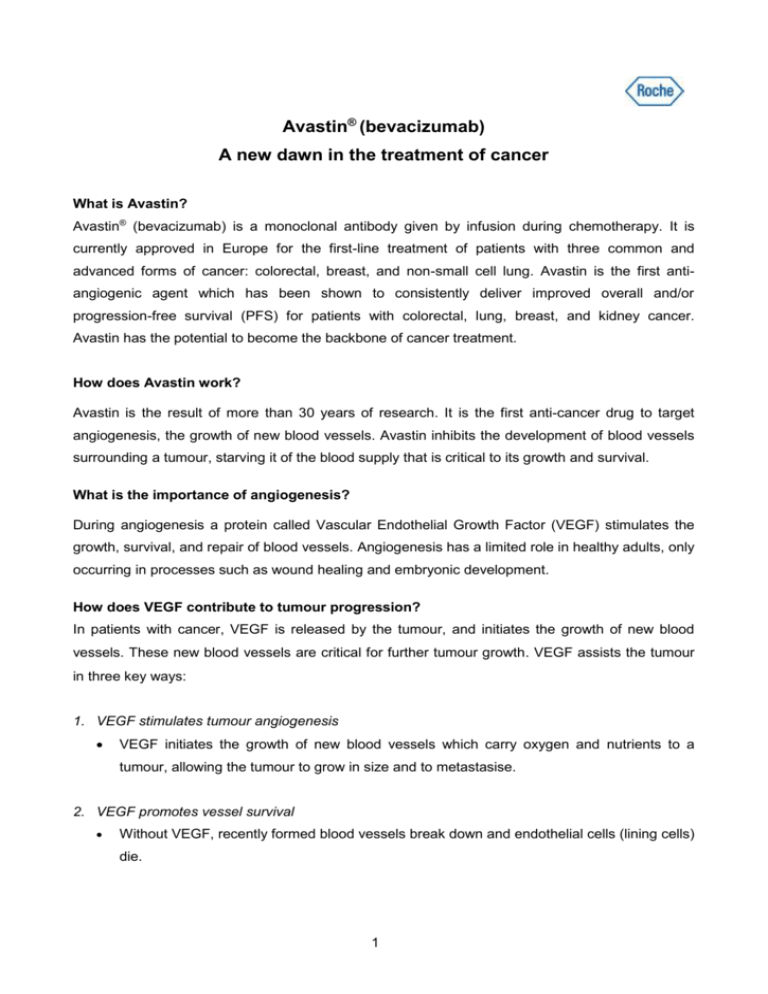
Avastin® (bevacizumab) A new dawn in the treatment of cancer What is Avastin? Avastin® (bevacizumab) is a monoclonal antibody given by infusion during chemotherapy. It is currently approved in Europe for the first-line treatment of patients with three common and advanced forms of cancer: colorectal, breast, and non-small cell lung. Avastin is the first antiangiogenic agent which has been shown to consistently deliver improved overall and/or progression-free survival (PFS) for patients with colorectal, lung, breast, and kidney cancer. Avastin has the potential to become the backbone of cancer treatment. How does Avastin work? Avastin is the result of more than 30 years of research. It is the first anti-cancer drug to target angiogenesis, the growth of new blood vessels. Avastin inhibits the development of blood vessels surrounding a tumour, starving it of the blood supply that is critical to its growth and survival. What is the importance of angiogenesis? During angiogenesis a protein called Vascular Endothelial Growth Factor (VEGF) stimulates the growth, survival, and repair of blood vessels. Angiogenesis has a limited role in healthy adults, only occurring in processes such as wound healing and embryonic development. How does VEGF contribute to tumour progression? In patients with cancer, VEGF is released by the tumour, and initiates the growth of new blood vessels. These new blood vessels are critical for further tumour growth. VEGF assists the tumour in three key ways: 1. VEGF stimulates tumour angiogenesis VEGF initiates the growth of new blood vessels which carry oxygen and nutrients to a tumour, allowing the tumour to grow in size and to metastasise. 2. VEGF promotes vessel survival Without VEGF, recently formed blood vessels break down and endothelial cells (lining cells) die. 1 3. VEGF increases vessel permeability The blood vessels supporting the tumour are immature and prone to leak. This abnormal permeability increases pressure on the tumour, which may impede the delivery of anticancer drugs. Avastin’s mechanism of action – a novel approach Avastin works through binding circulating VEGF thereby stopping the signal for angiogenesis. Tumour VEGF Avastin Just as VEGF assists the tumour in three ways, Avastin combats the tumour in three key ways: 1. Avastin causes shrinking of blood vessels Avastin causes the small blood vessels around the tumour to shrink away helping to stop the supply of oxygen and nutrients the tumour needs. 2. Avastin ‘normalises’ existing blood vessels Avastin causes the existing mature blood vessels to change shape in ways that help the chemotherapy reach the tumour more effectively. 3. Avastin stops the growth of new blood vessels Avastin inhibits the growth of new blood vessels and of a new blood supply to the tumour. 2 What clinical evidence demonstrates the efficacy of Avastin in colorectal cancer? In May 2003, a pivotal phase III trial found that Avastin gave the most significant improvement in survival time ever observed in advanced colorectal cancer involving an anti-angiogenic agent when used in first-line in combination with conventional chemotherapy (5-fluorouracil/folinic acid or intravenous 5-fluorouracil/folinic acid/irinotecan). The addition of Avastin to chemotherapy extended median overall survival by 5 months (20.3 months versus 15.6 months) for patients with previously untreated metastatic colorectal cancer.1 Avastin became the first anti-angiogenic treatment for cancer to be approved by the FDA for use in advanced colorectal cancer in February 2004, and subsequently by the EMEA in January 2005. In addition, a large international Phase III study in patients that received first-line treatment in colorectal cancer confirmed that the addition of Avastin to oxaliplatin-based chemotherapy (FOLFOX or XELOX) improved PFS by 43% over chemotherapy alone. Specifically there was also a statistically significant improvement in PFS when assessing the addition of Avastin to either the XELOX or FOLFOX subgroup.2 What clinical evidence demonstrates the efficacy of Avastin in breast cancer? Phase III trial results showed that Avastin doubles the chances of PFS in patients diagnosed with locally recurrent or metastatic breast cancer when used in combination with first-line paclitaxel (originally branded Taxol) chemotherapy.3 Specifically, the results showed that patients receiving Avastin plus paclitaxel had a median PFS of more than a year (13.3 months) while patients receiving paclitaxel alone had a median PFS of approximately 7 (6.7 months) months. In March 2007, Avastin was approved by the European Commission for the first-line treatment of women with metastatic breast cancer in combination with paclitaxel. What clinical evidence demonstrates the efficacy of Avastin in NSCLC? Phase III trial results from the Eastern Cooperative Oncology Group (E4599) study found Avastin to be the first medicine to extend survival beyond one year in previously untreated patients with advanced NSCLC. The study showed that the median duration of survival in the Avastin plus paclitaxel and carboplatin chemotherapy group was 12.3 months compared to 10.3 months in the group treated with chemotherapy alone. Overall patients treated with Avastin plus chemotherapy had an approximate 27 percent improvement in survival compared to those receiving chemotherapy alone.4 A second study, the ‘Avastin in Lung’ (AVAiL) phase III trial, demonstrated that when Avastin is combined with a different platinum-based chemotherapy backbone (cisplatin/gemcitabine), patients 3 with untreated advanced NSCLC show a 20 to 30 percent improvement in PFS, compared with those who received chemotherapy alone. This benefit was seen in patients who received either one of two different Avastin doses (7.5mg/kg or 15mg/kg) investigated in the trial.5 Further analyses of AVAiL are underway and results will be presented at upcoming oncology congresses. Avastin was approved by the FDA for the treatment of NSCLC in October 2006, following priority review. Moreover, Avastin was approved in August 2007 for the treatment of patients with NSCLC in Europe. This more recent approval was based on data from the E4599 and the AVAiL trials, which together demonstrated that Avastin was effective with a broad, platinum-based chemotherapy range. What clinical evidence demonstrates the efficacy of Avastin in renal cell cancer? An interim analysis of the phase III AVOREN study in patients with advanced renal cell cancer revealed that adding Avastin to interferon gave patients the chance to live twice as long without their disease progressing compared with interferon alone, extending PFS from a median of 5.4 to 10.2 months, respectively. 5 In December 2007, Avastin was approved by the European Commission for the first-line treatment of patients with advanced and/or metastatic RCC in combination with interferon, the current standard of care. Is Avastin being studied in further tumour types? A truly groundbreaking anti-cancer therapy, Avastin looks set to change the way cancer is treated with trials in many other cancer types. Roche and Genentech continue to research the clinical benefit of Avastin in other cancers, such as prostate, ovarian, cervical, and pancreatic cancers. References 1. Hurwitz H, Fehrenbacher L, Novotny W et al. Addition of bevacizumab (rhuMab-VEGF) to bolus IFL in the first-line treatment of patients with metastatic colorectal cancer: results of a randomized Phase III trial. New England Journal of Medicine 2004; 350(23): 2335–42. 2. Study NO16966 presented at ASCO GI 2007. 3. E2100 study. Roche, Data on file provided to regulatory authorities in 2006. 4. Sandler A et al. Paclitaxel-Carboplatin Alone or with Bevacizumab for Non-Small-Cell Lung Cancer. New England Journal of Medicine 2006; 355:2542-50. 5. Roche data on file. 4

